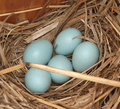Eastern bluebird facts for kids
The eastern bluebird (Sialia sialis) is a beautiful bird known for its bright blue feathers. It belongs to the Turdidae family, which includes thrushes. You can often spot these birds in many parts of North America.
Contents
What Eastern Bluebirds Look Like
Male eastern bluebirds are very striking. They have a bright blue back and a chest that is a mix of orange and blue. Their belly and the area under their tail are white.
Female bluebirds have softer colors. Their back is more of a blue-gray, but their tail and wings are a brighter blue. Their belly is a mix of orange-brown and white.
Where Eastern Bluebirds Live
Eastern bluebirds live in many places across North America. You can often find them in the American Midwest and southern Canada. They don't have just one type of home.
These birds like light woods, gardens, farms, and orchards. They prefer to use holes that are already made for their nests. For example, they often live in old woodpecker holes. To make these holes cozy, they add small twigs and brushwood. This material covers the bottom of their wooden home.
What Eastern Bluebirds Eat
Eastern bluebirds mostly eat insects. In summer and spring, they sit on a low branch or a nest box. From there, they look for bugs. When they spot one, they quickly fly down to catch it.
During colder seasons, insects are harder to find. So, bluebirds also eat small fruits. They enjoy berries found in fields or forests.
Eastern Bluebird Population
Female eastern bluebirds usually lay between four and five eggs at a time. The eggs hatch after about fourteen days of incubation.
Sadly, the number of eastern bluebirds has been going down. Even though many eggs are laid, not all of them survive. One reason for this might be the introduction of the common starling from Europe. Starlings are strong birds that compete with bluebirds for nesting spots. If bluebirds have to fight for a home, females might not be able to lay their eggs safely.
However, things could be worse without human help. Many people put up special nest boxes. These boxes give eastern bluebirds a safe place to build their nests and raise their young.
Images for kids
See also
 In Spanish: Azulejo gorjicanelo para niños
In Spanish: Azulejo gorjicanelo para niños






